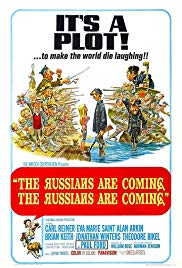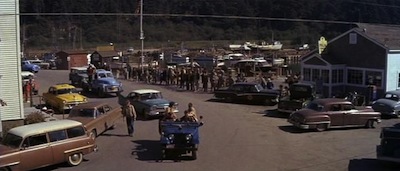The time is the Cold War. A Russian submarine has run aground near an island off the New England coast and a landing party is put ashore. Its mission: to steal a boat and tow the sub out to sea. The islanders think that the sailers are the beginning of a Soviet invasion. Some want to organize to resist … and the hilarious hijinks begin.
Selected Awards:
1967 Golden Globe Awards: Best Film-Musical/Comedy, Best Actor-Musical/Comedy (Arkin); 1966 National Board of Review Awards: Ten Best Films of the Year; 1966 Academy Awards Nominations: Best Picture, Best Actor (Arkin), Best Film Editing, Best Story & Screenplay.
Featured Actors:
Alan Arkin, Carl Reiner, Theodore Bikel, Eva Marie Saint, Brian Keith, Paul Ford, Jonathan Winters, John Philip Law, Ben Blue.
Director:
Norman Jewison.
This movie is funny on its own and children love it. When you describe for children the fear and distrust between Russians and Americans and some of the divisions among Americans during the Cold War, the film is much more amusing. “The Russians are Coming! The Russians are Coming!” is an excellent introduction to these issues.
Briefly describe the Cold War. See the Helpful Background section. Ask and help your child to answer the Quick Discussion Question.
Before its collapse in 1991, the Soviet Union was extremely powerful and well armed. It was regarded in the United States as a dangerous adversary. The Russians felt the same way about the U.S.
The Cold War began almost immediately after the end of World War II and extended until 1991. During that time, the U.S. and the U.S.S.R. armed themselves to the teeth fought several limited wars (e.g., Korea, Vietnam, Afghanistan) and competed for global ascendency. Finally, the economy of the Soviet Union was unable to maintain the military expenditures necessary to compete with the United States. Mikhail Gorbachev, the last leader of the Soviet Union, realized that his country needed economic and political freedom. His reforms started a process that culminated in the abandonment of the communist economic and political system. The Soviet Union collapsed in 1991 when Red Army soldiers refused to move against the Russian Parliament. At that time it was protected only by Russian citizens engaged in non-violent civil disobedience. See Learning Guide to “Gandhi”.
PEACE/PEACEMAKERS
See Quick Discussion Question.
Discussion Questions Relating to Ethical Issues will facilitate the use of this film to teach ethical principles and critical viewing. Additional questions are set out below.
CARING
(Be kind; Be compassionate and show you care; Express gratitude; Forgive others; Help people in need)
1. What was it that averted tragedy in this film?
This Learning Guide was last updated on December 17, 2009.



